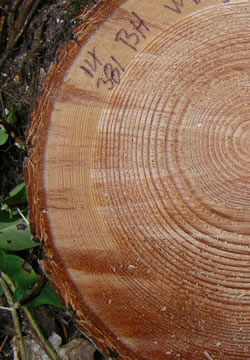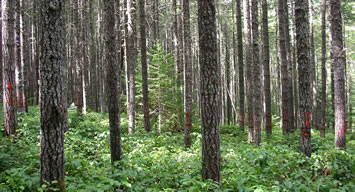Coastal second-growth forests
Getting the most value from each tree
Some of the most productive forests in the world are found in coastal British Columbia. The distinct mix of species and fibre attributes in coastal forests makes them unique not only in Canada but in the world.
Second-growth forests replace old-growth forests after natural disturbances, such as wildfire or wind-throw, or after harvesting. In coastal British Columbia, providing forest-dependent communities with access to a sustainable supply of high-quality timber, while protecting the unique coastal environment, requires careful management and use of second-growth forests.

Tree growth accelerates as a result of thinning and fertilization
The main goal of forest management has long been considered to be the increased production of wood. However, the need to maximize the economic value of forests has resulted in a shift toward a focus on getting the most value from every tree.
The Canadian Wood Fibre Centre, in collaboration with several industry, provincial and academic partners, is conducting research on second-growth coastal forests aimed at developing a range of tools that will allow foresters to make informed decisions that take into account multiple objectives, such as economic, social and recreational values.
These predictive tools will evaluate the economic impact of forest practices on the quality and quantity of wood products. They include efficient and accurate non-destructive evaluation of fibre attributes; remote sensing of forest structure, using technologies such as airborne laser and hyperspectral sensors; advanced modeling techniques; and statistical and economic analysis. Using this integrated approach in coastal second-growth forests will ultimately contribute to increasing the competitiveness of the Canadian forest sector in the global market.

Thinned and fertilized plot at the Shawnigan Lake Research Forest
Long-term studies at the Shawnigan Lake Research Forest
Data from long-term experimental studies, along with data from other industrial trials, are contributing to the development of predictive tools for foresters. For example, the Shawnigan Lake Research Forest, established more than 40 years ago and now one of the oldest coastal research forests, has been measured repeatedly to study the biology and development of second-growth Douglas-fir ecosystems in relation to intensive forest management practices (i.e., thinning and fertilization). In addition, it provides forest scientists with the opportunity to develop optimization models that predict fibre attributes and economic value.
Canadian Forest Service key contact
Cosmin Filipescu, Research Scientist
Page details
- Date modified: